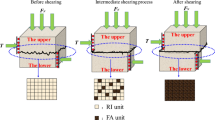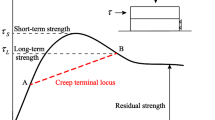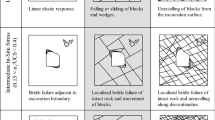Abstract
The shear strength of rock joints is an important factor to be considered when analyzing the stability of jointed rock mass. Rock joints tend to have smaller shear resistances in the reverse shearing than that of the forward shearing. A conceptual model describing the general shear behavior of rock joints under cyclic loading and the Barton–Bandis joint model considering the surface roughness degradation are implemented into the two-dimensional discontinuous deformation analysis (DDA) model. The modified DDA model is empirically validated by cyclic shear tests on two types of rock joints. Numerical simulations agree well with the experimental results, indicating that the DDA model is capable of describing the varying shear behaviors of rock joints subjected to cyclic loading conditions.










Similar content being viewed by others
Abbreviations
- \(R_{\text{n}}\) :
-
Normal component of the contact force
- \(k_{\text{n}}\) :
-
Stiffness of the normal springs
- \(d_{\text{n}}\) :
-
Penetration in normal direction
- \(R_{\text{s}}\) :
-
Shear component of the contact force
- \(k_{\text{s}}\) :
-
Stiffness of the shear springs
- \(d_{\text{s}}\) :
-
Relative shear displacement of the contact
- \(\emptyset\) :
-
Joint friction angle
- \(c\) :
-
Cohesion per unit length
- \(l_{\text{c}}\) :
-
Computed length of the contact
- \(\sigma_{\text{n}}\) :
-
Normal stress acting on the joint
- \(\emptyset_{\text{r}}\) :
-
Residual friction angle
- \(\emptyset_{\text{b}}\) :
-
Base friction angle
- M :
-
Damage parameter
- \(R_{{{\text{s}},{\text{peak}}}}\) :
-
Peak shear force of the angle-edge contact
- \(d_{{{\text{s}},{\text{peak}}}}\) :
-
Shear displacement required to reach the peak shear strength \(R_{{{\text{s}},{\text{peak}}}}\)
- DDA:
-
Discontinuous deformation analysis
- JRC:
-
Joint roughness coefficient
- JCS:
-
Joint compressive strength
- \({\text{JRC}}_{\text{mob}}\) :
-
Mobilized joint roughness
- \({\text{JRC}}_{\text{peak}}\) :
-
Peak JRC value before degradation
References
Bakun-Mazor D, Hatzor YH, Glaser SD (2012) Dynamic sliding of tetrahedral wedge: the role of interface friction. Int J Numer Anal Meth Geomech 36:327–343
Barton N (1973) Review of a new shear-strength criterion for rock joints. Eng Geol 7:287–332
Barton N (1982) Modelling rock joint behavior from in situ block tests: implications for nuclear waste respository design. Office of Nuclear Waste Isolation, Columbus, OH, 96 pp, ONWI-308
Barton N, Bandis S (1982) Effects of block size on the shear behaviour of jointed rock. Keynote lecture. In: 23rd US symposium on rock mechanics, Berkeley, California
Fathi A, Moradian Z, Rivard P, Ballivy G, Boyd AJ (2016) Geometric effect of asperities on shear mechanism of rock joints. Rock Mech Rock Eng 49:801–820. doi:10.1007/s00603-015-0799-6
Ghosh A, Hsiung SM, Chowdhury AH (1995) Seismic response of rock joints and jointed rock mass. Technical report, NUREG/CR-6388, CNWRA 95 013
Huang X, Haimson BC, Plesha ME, Qiu X (1993) An investigation of the mechanics of rock joints—part I. Laboratory investigation. Int J Rock Mech Min Sci Geomech Abstr 30:257–269
Hutson RW, Dowding CH (1990) Joint asperity degradation during cyclic shear. Int J Rock Mech Min Sci Geomech Abstr 27:109–119
Irie K, Koyama T, Hamasaki E, Nishiyama S, Shimaoka K, Ohnishi Y (2009) DDA simulations for huge landslides in Aratozawa Area, Miyagi, Janpan caused by Iwate-Miyagi Nairiku earthquake. In: Ma GW, Zhou YX (eds) Analysis of discontinuous deformation: new developments and applications. Research Publishing Services, Singapore, pp 153–160
Jing L, Stephansson O, Nordlund E (1993) Study of rock joints under cyclic loading conditions. Rock Mech Rock Eng 26:215–232
Ladanyi B, Archambault G (1969) Simulation of the shear behaviour of a jointed rock mass. In: The 11th symposium on rock mechanics, Berkeley, pp 105–125
Lee HS, Park YJ, Cho TF, You KH (2001) Influence of asperity degradation on the mechanical behavior of rough rock joints under cyclic shear loading. Int J Rock Mech Min Sci 38:967–980
Miyagi T, Yamashina S, Esaka F, Abe S (2011) Massive landslide triggered by 2008 Iwate–Miyagi inland earthquake in the Aratozawa Dam area, Tohoku, Japan. Landslides 8:99–108. doi:10.1007/s10346-010-0226-8
Ning Y, Zhao Z (2013) A detailed investigation of block dynamic sliding by the discontinuous deformation analysis. Int J Numer Anal Meth Geomech 37:2373–2393. doi:10.1002/nag.2140
Patton FD (1966) Multiple modes of shear failure in rock. In: Proceedings of the first congress ISRM, Lisbon, pp 509–513
Plesha ME (1987) Constitutive models for rock discontinuities with dilatancy and surface degradation. Int J Numer Anal Meth Geomech 11:345–362
Shi GH (1988) Discontinous deformation Analysis. PhD thesis, University of California, Berkeley, USA
Shi GH (1993) Block system modeling by discontinuous deformation analysis. Computational Mechanics Publications, Southampton
Sitar N, MacLaughlin M, Doolin D (2005) Influence of kinematics on landslide mobility and failure mode. J Geotech Geoenviron Eng 131:716–728
Tang Z, Liu Q, Xia C, Song Y, Huang J, Wang C (2014) Mechanical model for predicting closure behavior of rock joints under normal stress. Rock Mech Rock Eng 47:2287
Wang L, Jiang H, Yang Z, Xu Y, Zhu X (2013) Development of discontinuous deformation analysis with displacement-dependent interface shear strength. Comput Geotech 47:91–101
Xia C, Tang Z, Xiao W, Song Y (2014) New peak shear strength criterion of rock joints based on quantified surface. Descr Rock Mech Rock Eng 47:387–400. doi:10.1007/s00603-013-0395-6
Zheng L, Chen G, Zhang Y, Zhang H (2013) Review of rock stability analysis using discontinuous deformation analysis. In: Feng H, Tan (eds) Rock characterisation, modelling and engineering design methods. Taylor & Francis Group, London, pp 491–591
Zheng H, Zhang P, Du X (2016) Dual form of discontinuous deformation analysis. Comput Methods Appl Mech Eng 305:196–216. doi:10.1016/j.cma.2016.03.008
Author information
Authors and Affiliations
Corresponding author
Rights and permissions
About this article
Cite this article
Ma, S., He, C., Zhao, Z. et al. Modeling of Rock Joints Under Cyclic Loading Conditions Using Discontinuous Deformation Analysis. Rock Mech Rock Eng 50, 1205–1215 (2017). https://doi.org/10.1007/s00603-016-1158-y
Received:
Accepted:
Published:
Issue Date:
DOI: https://doi.org/10.1007/s00603-016-1158-y




